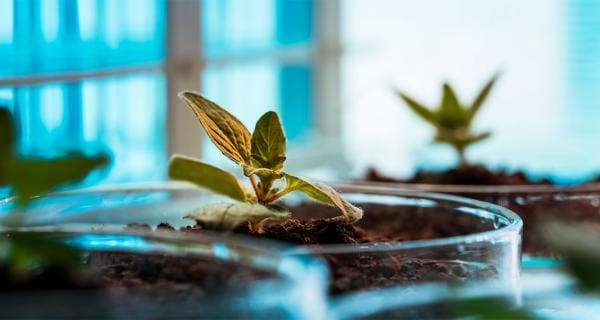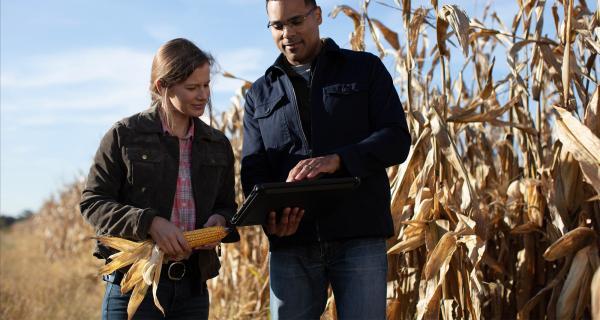Crop Science Resource Library
Finding science-based information about modern agriculture that is general enough for all audiences but also sharable in classrooms, online, or at conferences can be difficult. We are passionate about providing materials for you to use whether it’s to bring agriculture in the classroom, write a research paper, or to dive deeper into the technical science for yourself. We invite you to share and distribute these resources.

Genetically modified crops (also referred to as genetically engineered or GMOs), help farmers to maximize each acre of farmland and reduce resources – water, land, energy – required to produce our food, fuel and fiber. GM crops enable the adoption of more sustainable farming methods like conservation tillage which reduces the amount of greenhouse gases (GHGs) leading to climate change. This section focuses on all things GMOs including sustainability, benefits, safety, animal feed and more.
/ GMO Basics
The resources in this section explain how GMOs are made, current GMOs on the market, and answer common questions.
- Genetically Modified Crops Agvocate Fact Sheet
- GMOs and How Our Food is Grown
- Genetic Traits Expressed in GMO Crops in the US
- What Is a GMO?
- History of Genetic Modification in Crops
- What Does GMO Stand for?
- GMOs and Animal Feed
- DELAYED INNOVATION - Why Are Overall Timelines Moving in the Wrong Direction?
- Feed Your Mind: Understanding GMOs
- Where Can You Find GMOs (FDA)
- Understanding GMOs (FDA)
- Feed Your Mind - Agricultural Biotechnology (FDA)
- Goldstein D. A. (2014). Tempest in a tea pot: How did the public conversation on genetically modified crops drift so far from the facts?. Journal of medical toxicology : official journal of the American College of Medical Toxicology, 10(2), 194–201.
- 2022 Study on the Time and Cost Required for the Discovery, Development, and Authorization of a New GM Trait
- Food and Agriculture Organization of the United Nation’s (FAO) role in biotechnology
- PG Economics
- Camille Ryan, Elizabeth Henggeler, Samantha Gilbert, Andrew J. Schaul & John T. Swarthout (2024) Exploring the GMO narrative through labeling: strategies, products, and politics, GM Crops & Food, 15:1, 51-66
/ Benefits and Sustainability
The resources in this section illustrate how GMOs are an important tool for farmers to maintain their land and grow food more sustainably.
- How do GMOs Help Improve Air Quality
- How do GMOs Help Improve Soil Health
- How do GMOs Help Preserve Water
- How do GMOs Help Reduce Food Waste and Loss
- How do GMOs Help Preserve Our Habitat
- How do GMOs Help Protect the Environment
- Celebrating 25 Years of Biotech
- How GMOs Play a Role in Sustainability
- Get to Know GMOs and the Environment
- GMO Potato - From Farm to Plate
- 3 Big Ways GMOs Help the Environment
- Fact - How GMOs Reduce Greenhouse Gas
- GMOs Outside the US
- Graham Brookes & Peter Barfoot. (2022). Farm income and production impacts from the use of genetically modified (GM) crop technology 1996–2020. GM Crops & Food. 13(1), 171-195.
- Graham Brookes & Peter Barfoot. (2018) .Environmental impacts of genetically modified (GM) crop use 1996-2016: Impacts on pesticide use and carbon emissions. GM Crops & Food. 9(3), 109-139.
/ Safety
As consumers ourselves, we are committed to developing products that contribute to safe and nutritious food choices – including our own families and friends. Extensive and continued studies on GM crops have been conducted globally by both the public sector and industry to ensure their ongoing safety. GM crops have been tested more than any other crop in the history of agriculture. The resources in this section help explain the testing that has been performed and regulatory processes that are in place to ensure that GM crops are as safe as conventional crops.
- Genetically Engineered Crops: Experience and Prospects – National Academies of Science, Engineering and Medicine (for a shorter version Report in Brief)
- A Decade of EU-Funded GMO Research – European Commission
- Vicini J.L. (2017). GMO crops in animal nutrition. Animal Frontiers. 7(2), 9–14.
- Van Eenennaam A.L. and Young A.E. (2014). Prevalence and impacts of genetically engineered feedstuffs on livestock populations. J.Amin. Sci. 92, 4255-4278.
Videos on GMOs

Farmers face many challenges in their fields such as weeds, pests, and disease. The annual loss in harvests can be up to 40% from weeds, insects, and diseases which could double without crop protection. Protecting crops with pesticides helps reduce food waste during food production. Pesticides are one tool farmers can use to complement other common and effective practices, such as cover crops, tilling, crop rotation, and proper timing of planting. The resources in this section address common questions that people have about pesticides including glyphosate, neonicotinoids, dicamba and biologics.
/ Crop Protection Basics
/ Glyphosate
- Glyphosate Agvocate Fact Sheet
- Glyphosate and the Environment
- IARC Cancer Classifications Examples
- 17 Questions About Glyphosate | Thoughtscapism
- Glyphosate Timeline
- Glyphosate Safety
- IARC Opinion an Outlier Infographic
- Glyphosate-Long-History of Safe Use Infographic
- Glyphosate Regulatory and Research Agency Conclusions
- Glyphosate Facts
- EPA - Glyphosate
- Research and Safety Record - The Truth about Glyphosate
- Glyphosate Renewal Group
- Brookes G., Taheripour F., and Tyner W.E. (2017). The contribution of glyphosate to agriculture and potential impact of restrictions on use at the global level. GM Crops & Food. 8(4), 216-228.
- Vicini, JL, Jensen, PK, Young, BM, & Swarthout, JT. Residues of glyphosate in food and dietary exposure. Compr Rev Food Sci Food Saf. 2021; 1– 32.
- Bayer's Contribution to a Fact-Based Public Discourse about Glyphosate
- A Future without Glyphosate and Farm Bill Implications - Aimpoint Research
/ Dicamba
- Roundup Ready® Xtend Crop System
- Riter L.S., Sall E.D., Pai N., Beachum C.E., Orr T.B. (2020). Quantifying dicamba volatility under field conditions: part I, methodology. J. Agric. Food Chem. 68(8),2277-2285
- Sall E.D., Huang K., Pai N., Schapaugh A.W., Honegger J.L., Orr T.B. and Riter L.S. (2020). Quantifying dicamba volatility under field conditions: part II, comparative analysis of 23 dicamba volatility field trials. J. Agric. Food Chem. 68(8),2286-2296.
/ Neonics
- Neonic Facts.org
- Stephenson G.L. & Solomon K.R. (2017). Quantitative weight of evidence assessment of higher-tier studies on the toxicity and risks of neonicotinoids in honeybees. 2. Imidacloprid. Journal of Toxicology and Environmental Health, Part B. 20(6-7), 330-345.
- Solomon K.R & Stephenson G.L. (2017). Quantitative weight of evidence assessment of higher tier studies on the toxicity and risks of neonicotinoids in honeybees. 3. Clothianidin. Journal of Toxicology and Environmental Health, Part B. 20(6-7), 346-364.
- Zaworra M. et al. (2019). Pharmacokinetics of Three Neonicotinoid Insecticides upon Contact Exposure in the Western Honey Bee, Apis mellifera. Chemical Research in Toxicology. 32(1), 35-37.
- Treated Seeds - A Proven Solution for Sustainable Crop Production
- Bayer Neonicotinoid Report
Videos on Crop Protection & Pesticides
/ Biologics
Videos on Biologics

Through generations of research and discovery, plant breeding has advanced beyond selecting a parent plant simply based on its appearance. It now includes an in-depth understanding of the genetic makeup of a plant, giving breeders the ability to better predict which plants will have the highest probability of success in the field and the grocery store before making a cross. The resources in this section focus on how plant breeding continues to improve upon what farmers have done for thousands of years, and face significant challenges like a changing climate, limited natural resources, reduced arable land and increased consumer demands.
Videos on Plant Breeding and Plant Breeding Innovation

Genome editing (also referred to as gene editing) has the potential to solve real challenges for farmers and the planet, like reducing the need for pesticides and the use of energy, land, and water. In agriculture, this process typically looks to improve a beneficial trait within an organism, or to remove an undesirable trait. The resources in this section focus on the most recent advancements in plant breeding technique improving seed products with greater efficiency and specificity than ever before.
- Innovature
- Genetic Literacy Project
- Council for Agricultural Science and Technology (CAST). 2018. Genome Editing in Agriculture: Methods, Applications, and Governance—A paper
- ISAAA - Plant Breeding Innovation - CRISPR-Cas9
- Graham, N., et al. (2020). Plant genome editing and the relevance of off-target changes. Plant Physiology.183(3),1194-2019.
- van de Wiel, C.C.M., Schaart, J.G., Lotz, L.A.P. et al. (2017). New traits in crops produced by genome editing techniques based on deletions. Plant Biotechnol Rep. 11, 1–8.
- Jenkins, D., Dobert, R., Atanassova, A. et al. Impacts of the regulatory environment for gene editing on delivering beneficial products. In Vitro Cell.Dev.Biol.-Plant (2021).
- Innovative Genomics Institute - CRISPR Made Simple
- CRISPRpedia
- Recent developments in biotechnologies relevant to the characterization, sustainable use and conservation of genetic resources for food and agriculture
Videos on Genome Editing

All life on the farm is interconnected—especially when it comes to pollination. While wind and water carry some pollen, animals help to pollinate an estimated 87.5 percent of flowering plant species. These animals come in many shapes, sizes, and numbers—including a diverse spectrum of life from honey bees to humans.
- Bayer for Biodiversity
- Biodiversity In the Community | Bayer United States
- Biodiversity Research & Resources | Bayer United States
- Enhance Biodiversity by Planting Your Own Pollinator Garden
- Reviving Monarch Butterfly Habitats
- Make Your Efforts Count with HabiTally
- Healthy Hives Research Initiative Given Additional $500,000 Commitment
- Beekeeping: Surviving a 35-Year Pandemic is possible
- Farmers for Monarchs - Collaborating to Save the Iconic Monarch Butterfly
- Bee and Butterfly Habitat Fund
- Monarch Watch
- Assessment Report on Pollinators, Pollination and Food Production
- Views on Insect Decline
- Buhk et al. (2018). Flower strip networks offer promising long term effects on pollinator species richness in intensively cultivated agricultural areas. BMC Ecology. 18, 55.
Videos on Pollinators

We’re committed to a world in which biodiversity thrives in harmony with humankind. Where hunger and climate change are terms relegated to history books. Where farms are more sustainable, consisting of plants that are more adaptive and resilient, to help increase economic prosperity for all families and their communities. In short, where agriculture is part of the solution to many of the planet’s biggest challenges.
Videos on Sustainability in Ag

As a leader in agriculture, Bayer has a responsibility to farmers, consumers, and the planet. While we have always held ourselves to a high standard, we aim to further elevate our efforts in transparency.
- The Quality and Scientific Integrity of Our Data
- Pesticide and Biopesticide - A guide to the stringent scientific testing required by EU Regulation
- Transparency Commitments Fact Sheet
- A guide to finding existing safety data (Crop Life International)
- A brief summary of the Bayer operator safety standards
- Bayer residue study performed under Good Laboratory Practices (GLPs)
- Sustainability and Responsibility improving Policies for Action in Safety Standards (SURPASS)
- Bayer Safety Standards - Ensuring Operator Safety
- Transparency at Bayer – Take a Look around Our Facilities
- Raising the bar on Transparency and Engagement
- Our Commitment to Transparency - Glyphosate Renewal Group
- Our Commitment to Transparency - CropLife International
- Digitalization and Platforms in Agriculture: Organizations, Power Asymmetry, and Collective Action Solutions - Berkley University of California
- Allison D.B. and Fineberg H.V. (2020). EPA’s proposed transparency rule: Factors to consider, many; planets to live on, one. Proceedings of the National Academy of Sciences. 117 (10), 5084-5087.
- Raising the Bar – Why Transparency?
Videos on Transparency
“Bayer Transparency Initiative: Crop Protection Safety Data”





Bayer is in partnership with external advocates of all kinds –and in many cases, we lean on our ag advocates (also known as “agvocates”) to share their own stories and help shape the dialogue. Here you will find resources that can make agriculture advocacy (agvocacy) and science communication even easier!
We’d love to hear from you, too. Feel free to submit questions to us at ScientificResources@bayer.com
- Conventional and Organic Ag Agvocate Fact Sheet
- Digital Farming Agvocate Fact Sheet
- Environmental Science Agvocate Fact Sheet
- Food Safety Agvocate Fact Sheet
- Smallholder Farming Agvocate Fact Sheet
- Soil Health Agvocate Fact Sheet
- Water Safety Agvocate Fact Sheet
- Tips for Success: Participating
In, Moderating, and Organizing a Panel
Discussion - Tips for Success: Connect and Make an Impact with Your Audience
- Tips for Success: Recording a Video on Your Smartphone
- Profiting from Disinformation: The Case of Genetically Modified Organisms - SCIPOD
- The Tomorrow Farm - a Bayer Podcast for Everyone with a Future on Planet Earth
- Talking Biotech with Kevin Folta
- SharkFarmer Podcast with Rob Sharkey
- AgTech360 with Adrian Percy
- Thinking Critically with Jonathan Maloney
- Dirt to Dinner Podcast
- 3Squares: Dishing on the Food Industry with Charlie Arnot
- Copa Cogeca - The united voice of farmers and their cooperatives in the European Union
- World Farmers' Organization
- GlobalFarmerNetwork.org
- Genetic Literacy Project
- Cornell Alliance for Science
- Ryan C.D., Schaul A.J., Butner R., Swarthout J.T. (2019). Monetizing disinformation in the attention economy: The case of genetically modified organisms (GMOs). European Management Journal. 38(1), 7-18.
- Lynn Sosnoskie – Weed Scientist
- Channa Prakash – Professor, Biotech Guru
- Diane Loew – Farmer’s Wife
- Val Giddings – Biotech Expert
- James Wong - Botanist
- Timothy Caulfield – Prof of Health Law & Science Policy
- Frank Mitloehner – UC Davis Prof – Animal Science
- Farm Babe – Science Communicator
- Jayson Lusk – Food & Ag Economist
Ag Advocacy and Sci Communications
Follow Us on Twitter
- Cami Ryan
- Larry Gilbertson
- Liza Dunn
- Bill Reeves
- Brittania Lebbing
- Aimee Hood
- Allison Devitre
- Klaus Kunz
- Shannon Hauf
- Sheilah Oltmans-Deardorff
- Aqeel Ahmad
- Jennifer Crall




















